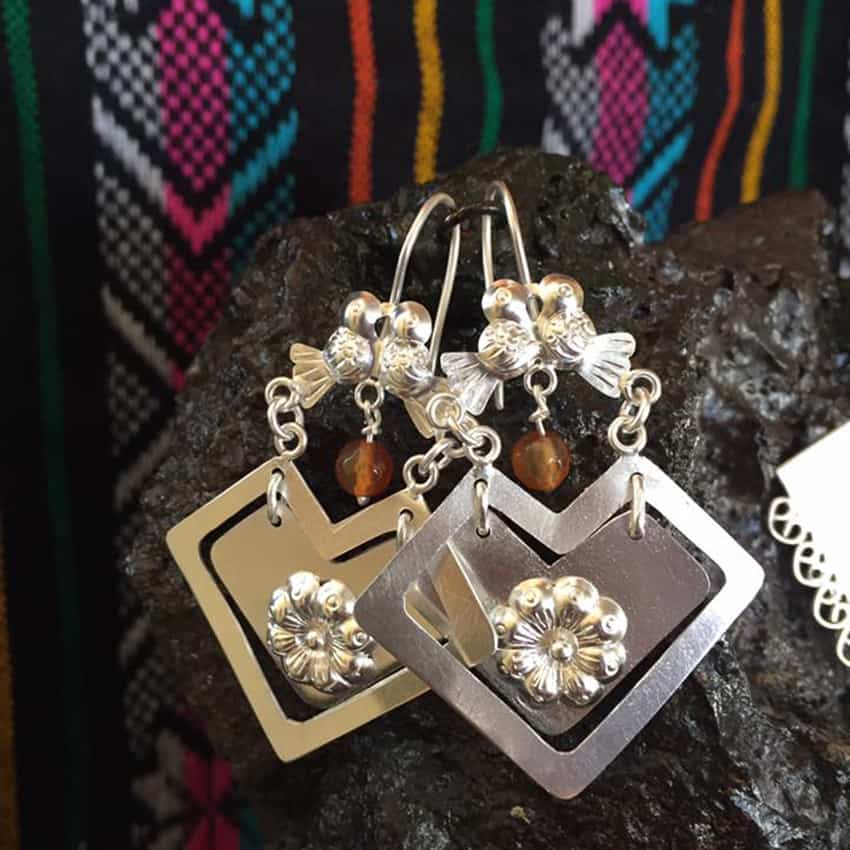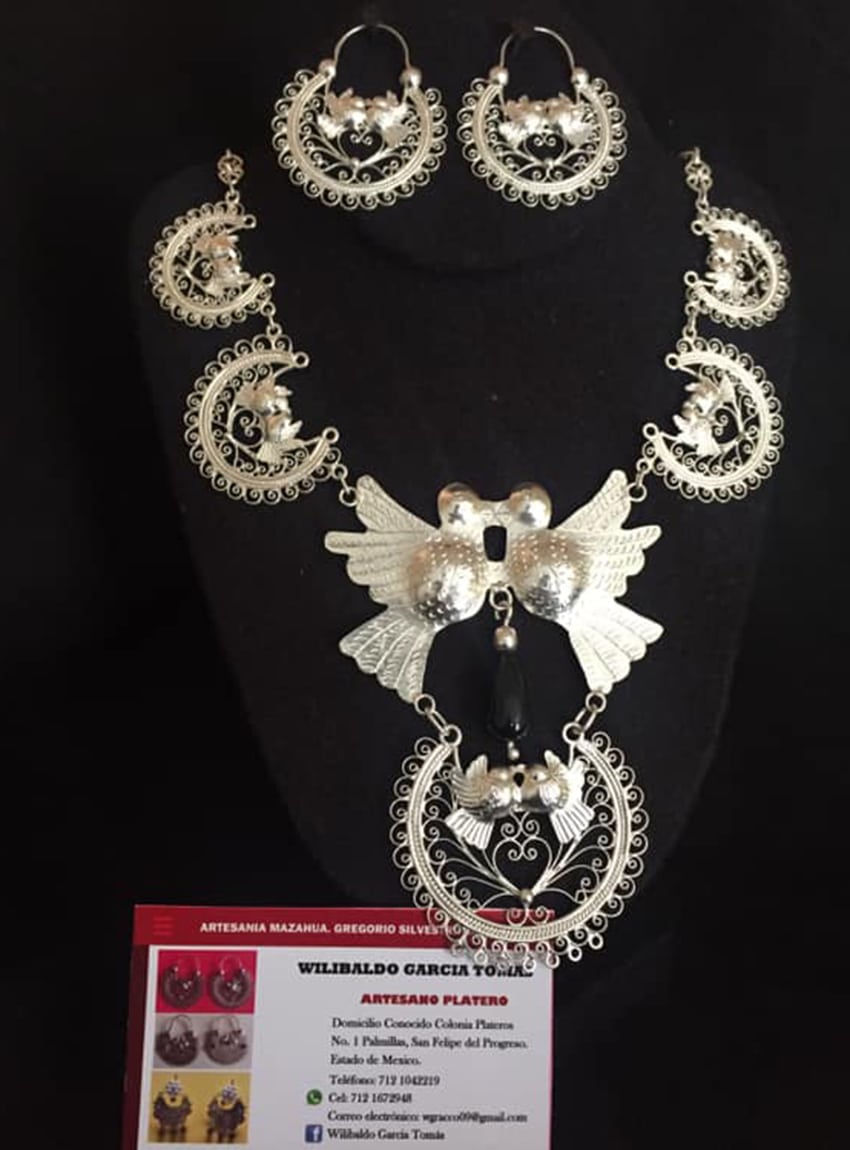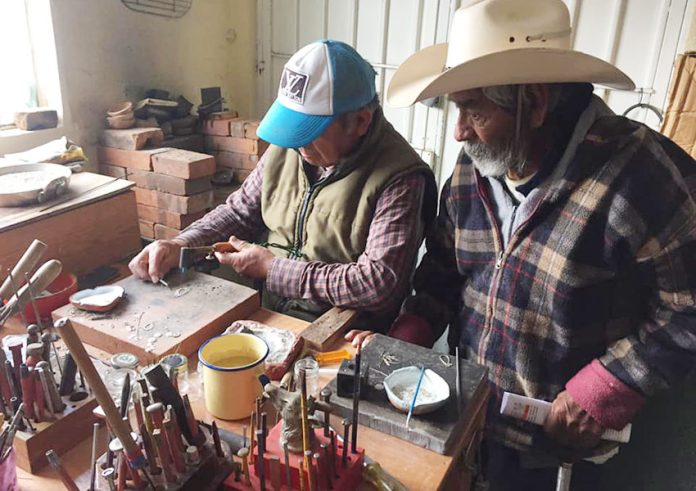José Wilibaldo García has a very understanding wife, and he needs to. This craftsman not only gave up a career in dentistry to work with silver but his jewelry has also brought him lots of attention from (female) jewelry lovers.
San Felipe del Progreso is about two hours northwest of Mexico City in México state. It is not easy to make a living here despite its proximity to the capital and the state’s industry. Deforestation and decimation of farmland have put great pressure on traditional lifestyles.
But one Mazahua tradition that remains, thanks to a few dedicated craftsmen like García, is the making of silver half-moon earrings.
These have a long history among Mazahua women. Made either with silver laminate or filigree, the earrings traditionally indicated a woman’s marital status in San Felipe del Progreso. Earrings with one dove meant the woman was single and with two, married. Originally, the earrings were made from silver coins as this was the way that indigenous people could get their hands on the precious metal.
By the 21st century, this need to advertise marital status died out, even among conservative Mazahua, and the making of earrings nearly died out as well.

Here is where García’s family comes in. His grandfather, Domingo García, was an oil painter who met a silversmith from Michoacán. The two decided to teach each other their specialties.
The knowledge of working silver was then passed onto Domingo’s sons, including Gregorio García Ruíz. Don Gregorio not only taught his own sons, including José Wilibaldo, but also a group of 30 young people in the small village of Palmillo.
His efforts got the attention of state cultural authorities, who granted him land and other resources to start a school and cooperative. It ran successfully for a time and has since disbanded, but the legacy of silver continues.
Don Gregorio was featured in Banamex’s Great Masters of Mexican Folk Art, a very authoritative book on traditional artisans. Although the maestro has made magnificent pieces, including silver sculptures, his bread and butter has always been jewelry, especially earrings.
José Wilibaldo carries on the tradition today, although that was not his original intention. He studied dentistry at school and had his own practice for many years, but perhaps he just couldn’t resist the genetic call to be more creative.
He admits that while silversmithing does not pay what dentistry does, it is much more satisfying.
He continues making the traditional half-moon earrings, both in filigree and laminate silver, but he hasn’t stopped there. He looks to create new products yet always keeps a connection to Mazahua tradition.
His most successful design effort has been the creation of earrings and pendants based on the indigenous quexquémitl, a triangular poncho-like garment common in central Mexico. The shape of the garment and its traditional decoration lend themselves quite well to the laminate technique, a style that blends innovation and tradition.
José Wilibaldo is also more open than many to the use of technology for sales and promotion, although this is never easy.
San Felipe is a rural area, and the rainy season (which we are entering) plays havoc with telephone and internet communications here. Nonetheless, he takes professional photos of his work and even videos to share on social media.
The García family has been fortunate to have been discovered not only by México state authorities but also by those outside of their region, such as the Feria Maestros del Arte. They invited Wilgart (the name of the family’s business) to their last handcraft fair in Chapala, Jalisco, before the pandemic, and the earrings and necklaces were quite a hit; I could not count all the pieces of silver moons and quexquémitls I saw on women walking around on the fairgrounds.
Many women also insist on having their picture taken with the maestro, leading to nonstop ribbing of José Wilibaldo from me about his popularity with the ladies.

Silversmiths such as the Garcías are important not only because they help to preserve and promote Mazahua culture but also because they break the idea that fine silverwork is only to be had in Taxco, Guerrero, which is famed for its silver jewelry production.
It is almost cliché to say that the pandemic has hurt artisans, but it has been particularly true for Wilgart. It’s particularly hard because silver jewelry is a luxury item, and many people in Mexico are having trouble meeting basic expenses.
Face-to-face venues have dried up, and even Wilibaldo’s internet presence has not resulted in the kinds of sales necessary to survive. He has two Facebook accounts, one dedicated to the business and the other his personal page. You can look at both to get a good sense of his product lines and history, but it is better to contact him through his personal page.
Yet, he is nothing if not perseverant. He may not be sure when things will get back to normal, nor when he can travel to events again, yet José Wilibaldo continues to work on pieces and experiment. Recently, he joined an online class with Oaxacan designer Maritza Villegas that focused on balancing innovation with the conservation of tradition.
There are still uncertainties ahead, but one thing is certain: when buyers are ready to return, he, and Wilgart, will be ready for them.
Leigh Thelmadatter arrived in Mexico 18 years ago and fell in love with the land and the culture in particular its handcrafts and art. She is the author of Mexican Cartonería: Paper, Paste and Fiesta (Schiffer 2019). Her culture column appears regularly on Mexico News Daily.
